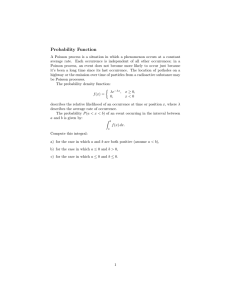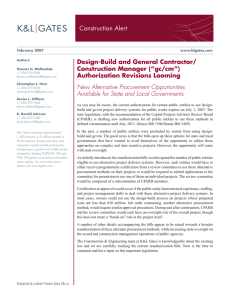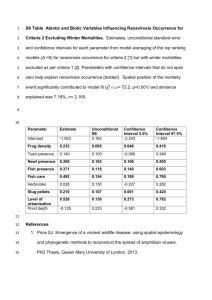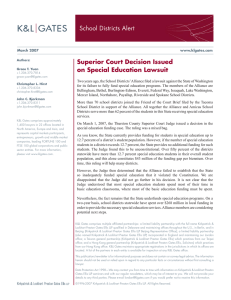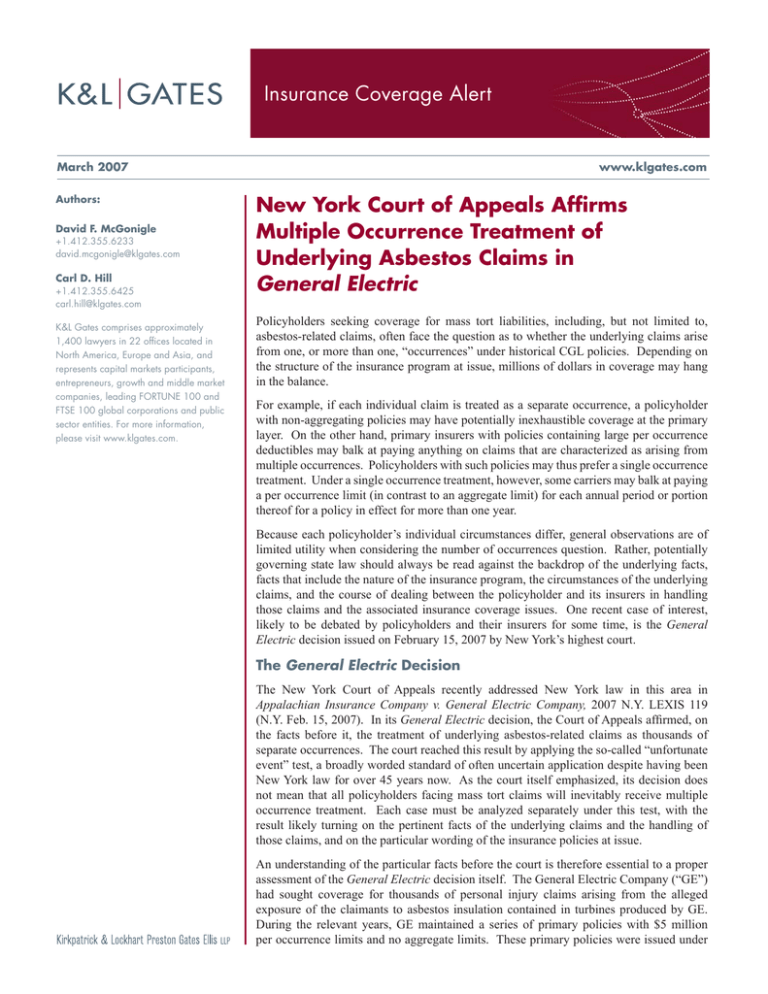
Insurance Coverage Alert
March 2007
Authors:
David F. McGonigle
+1.412.355.6233
david.mcgonigle@klgates.com
Carl D. Hill
+1.412.355.6425
carl.hill@klgates.com
K&L Gates comprises approximately
1,400 lawyers in 22 offices located in
North America, Europe and Asia, and
represents capital markets participants,
entrepreneurs, growth and middle market
companies, leading FORTUNE 100 and
FTSE 100 global corporations and public
sector entities. For more information,
please visit www.klgates.com.
www.klgates.com
New York Court of Appeals Affirms
Multiple Occurrence Treatment of
Underlying Asbestos Claims in
General Electric
Policyholders seeking coverage for mass tort liabilities, including, but not limited to,
asbestos-related claims, often face the question as to whether the underlying claims arise
from one, or more than one, “occurrences” under historical CGL policies. Depending on
the structure of the insurance program at issue, millions of dollars in coverage may hang
in the balance.
For example, if each individual claim is treated as a separate occurrence, a policyholder
with non-aggregating policies may have potentially inexhaustible coverage at the primary
layer. On the other hand, primary insurers with policies containing large per occurrence
deductibles may balk at paying anything on claims that are characterized as arising from
multiple occurrences. Policyholders with such policies may thus prefer a single occurrence
treatment. Under a single occurrence treatment, however, some carriers may balk at paying
a per occurrence limit (in contrast to an aggregate limit) for each annual period or portion
thereof for a policy in effect for more than one year.
Because each policyholder’s individual circumstances differ, general observations are of
limited utility when considering the number of occurrences question. Rather, potentially
governing state law should always be read against the backdrop of the underlying facts,
facts that include the nature of the insurance program, the circumstances of the underlying
claims, and the course of dealing between the policyholder and its insurers in handling
those claims and the associated insurance coverage issues. One recent case of interest,
likely to be debated by policyholders and their insurers for some time, is the General
Electric decision issued on February 15, 2007 by New York’s highest court.
The General Electric Decision
The New York Court of Appeals recently addressed New York law in this area in
Appalachian Insurance Company v. General Electric Company, 2007 N.Y. LEXIS 119
(N.Y. Feb. 15, 2007). In its General Electric decision, the Court of Appeals affirmed, on
the facts before it, the treatment of underlying asbestos-related claims as thousands of
separate occurrences. The court reached this result by applying the so-called “unfortunate
event” test, a broadly worded standard of often uncertain application despite having been
New York law for over 45 years now. As the court itself emphasized, its decision does
not mean that all policyholders facing mass tort claims will inevitably receive multiple
occurrence treatment. Each case must be analyzed separately under this test, with the
result likely turning on the pertinent facts of the underlying claims and the handling of
those claims, and on the particular wording of the insurance policies at issue.
An understanding of the particular facts before the court is therefore essential to a proper
assessment of the General Electric decision itself. The General Electric Company (“GE”)
had sought coverage for thousands of personal injury claims arising from the alleged
exposure of the claimants to asbestos insulation contained in turbines produced by GE.
During the relevant years, GE maintained a series of primary policies with $5 million
per occurrence limits and no aggregate limits. These primary policies were issued under
Insurance Coverage Alert
a retrospective rating plan that functioned like a
self-insured retention or deductible under which GE
reimbursed the insurer for claims paid. Because no
individual underlying claim was likely to exceed $5
million, GE’s strategy for reaching its excess layers
of coverage was to have the underlying claims
aggregated.
When the number of asbestos-related claims filed
against GE began to spike in 1991, GE negotiated a
claims handling agreement with the primary carrier
(an industry captive insurer which it and its employees
partially owned) under which all claims associated
with a single product line—such as turbines—would
constitute a single occurrence.1 One of GE’s excess
insurers filed a declaratory judgment action in 1996
to resolve, inter alia, the number of occurrences
issue. After receiving an adverse ruling on summary
judgment, GE appealed to and lost at the Appellate
Division level, setting the stage for the New York
Court of Appeals to address the issue.
GE had argued that the various asbestos-related
claims brought against it should be treated as a single
occurrence because all could be traced to GE’s failure
to warn of the danger of exposure to asbestos insulation
in its turbines. The Court of Appeals affirmed the
lower court’s ruling that GE’s argument failed under
the “unfortunate event” test as originally set forth in
Arthur A. Johnson Corp. v. Indemnity Ins. Co. of N.
Am., 164 N.E.2d 704, 707 (N.Y. 1959). Under that
test, “the focus should be on the event for which the
insured is being held liable, not a point further back
in the causal chain.”2 Applying this test, the court
1
The captive primary insurer originally treated the claims as
arising from separate occurrences. General Electric, 2007 N.Y.
LEXIS 119 at *5-*6. GE and the insurer then decided to treat the
claims as arising from a single occurrence, and GE did not contend
that the excess insurers were bound by the retroactive construction
of the term “occurrence” in that agreement. Id. at *7.
2
Id. at *8. While acknowledging that causation was pertinent
to its analysis, the court also noted that “the cause should not be
conflated with the incident” that constitutes the “unfortunate
event.” Id. at *13. The court therefore rejected GE’s focus on the
alleged common cause of the events giving rise to liability, which
was allegedly its failure to warn. Id. at *13 n.2. In this regard, New
York law may be in the minority. According to some commentators
and courts, the majority approach determines the number of
occurrences based on their cause and not necessarily the event for
which the policyholder is held liable. See Michael P. Sullivan,
Annotation, What Constitutes a Single Accident or Occurrence
Within Liability Policy Limiting Insurer’s Liability to a Specified
Amount Per Accident or Occurrence, 64 A.L.R. 4th 668, at § 2[a]
(2006); Washoe County v. Transcontinental Ins. Co., 878 P.2d 306,
308 (Nev. 1994) (describing the “causal approach” as that used by
the “vast majority of jurisdictions”).
went on to hold that GE’s alleged failure to warn only
created the potential for liability and that it was each
individual exposure that actually created liability.3
Hence, each individual exposure would be treated as
a separate occurrence.
The court also noted, however, that its ruling did not
“necessarily bar excess coverage in multi-plaintiff
mass tort contexts. Each mass tort scenario must be
examined separately under the Johnson rule.”4 For
example, “a series of explosions, the actual release of
hazardous substance, or some other calamity, that will
result in numerous injuries or losses” could potentially
allow these injuries or losses to be grouped together.5
Crucial here is whether each individual injury or loss
stands in sufficient temporal and spatial proximity
to the other and whether the events are part of the
“same causal continuum, without intervening agents
or factors.”6
The court found that the facts pertinent to the underlying
asbestos claims against GE did not allow them to be
grouped as a single occurrence. The turbines at issue
were “custom-designed based on the specific needs
of GE customers, with little or no uniformity in the
amounts or types of asbestos insulation incorporated
into the design. Moreover, the exposure of the
individual plaintiffs varied in duration and intensity
and occurred over decades at more than 22,000 work
sites throughout the nation.”7 Of course, a different
result could be reached under different facts.8
3
General Electric, 2007 N.Y. LEXIS 119 at *16.
Id. at *18.
5
Id.
6
Id. at *13. For example, the court noted that Johnson treated
as separate occurrences the collapse of two independent walls of
adjoining buildings that occurred almost an hour apart. Id. While
both collapses were due to the same heavy rainfall, the first collapse
did not cause the second. In contrast, the court subsequently treated
as a single occurrence a three-car collision where the policyholder’s
automobile struck one vehicle, ricocheted off and struck a second
more than 100 feet away. Id. (citing Hartford Acc. & Indem. Co. v.
Wesolowski, 305 N.E.2d 907 (N.Y. 1973)).
7
Id. at *8.
8
See, e.g., Uniroyal, Inc. v. Home Ins. Co., 707 F. Supp. 1368,
1381-83 (E.D.N.Y. 1988) (finding that numerous claims related to
Agent Orange exposure amounted to a single occurrence, with the
“unfortunate event” being the insured’s delivery of Agent Orange
to the military); National Union Fire Ins. Co. of Pittsburgh, Pa.
v. Stroh Cos., Inc., No. 98 Civ. 8248 (DLC), 2000 WL 264320
(S.D.N.Y. 2000), aff’d, 265 F.3d 97 (2d Cir. 2001) (holding that
multiple claims resulting from a defective production run in a
bottling plant amounted to one occurrence); Mark IV Indus., Inc.
v. Lumbermens Mut. Cas. Co., No. 2005/2029, 2006 WL 1458245,
at *3 (N.Y. Sup. Apr. 28, 2006) (concurring with the parties that
continuous repeated manufacture and sale of defectively designed
washing machine inlet hoses constituted a single occurrence). The
4
March 2007 | 2
Insurance Coverage Alert
The Court of Appeals also noted that parties to
insurance contracts are free to adopt language that
would supersede the unfortunate event test and
provide other methods for grouping claims against
the policyholder into one or more occurrences.9
For example, many policies contain language that
expands the definition of occurrence to allow for a
“continuous or repeated exposure to substantially the
same conditions [to] be considered as arising out of
one occurrence.”10
Conclusion
The General Electric decision provides useful guidance
on New York’s “unfortunate events” test, under the
specific facts before the court. Policyholders facing
the number of occurrences question under New York
law should, however, undertake a detailed review of
their own particular facts and circumstances before
drawing any firm conclusions on the potential effect
of the decision on their own claims.
Second Circuit has also recently held in the context of coverage
claims arising out of the World Trade Center disaster that the
“unfortunate event” test was “considerably more nuanced” than
the insurers and insureds contended, particularly in the context
of property policies, and raised issues that must be put to a factfinder. World Trade Center Prop. v. The Travelers Indem. Co., 345
F.3d 154, 188 (2d Cir. 2003). In addition, the General Electric
decision did not present the court with the question of the effect of
a reasonable settlement between a policyholder and an unaffiliated
primary insurer as regards the number of occurrences question.
9
General Electric, 2007 N.Y. LEXIS 119 at *14.
10
Id. at *15 n.3 (citing Metropolitan Life Ins. Co. v. Aetna Cas. &
Sur. Co., 765 A.2d 891, 898-99 (Conn. 2001)).
K&L Gates comprises multiple affiliated partnerships: a limited liability partnership with the full name Kirkpatrick & Lockhart Preston Gates Ellis
LLP qualified in Delaware and maintaining offices throughout the U.S., in Berlin, and in Beijing (Kirkpatrick & Lockhart Preston Gates Ellis LLP
Beijing Representative Office); a limited liability partnership (also named Kirkpatrick & Lockhart Preston Gates Ellis LLP) incorporated in England
and maintaining our London office; a Taiwan general partnership (Kirkpatrick & Lockhart Preston Gates Ellis) which practices from our Taipei
office; and a Hong Kong general partnership (Kirkpatrick & Lockhart Preston Gates Ellis, Solicitors) which practices from our Hong Kong office.
K&L Gates maintains appropriate registrations in the jurisdictions in which its offices are located. A list of the partners in each entity is available
for inspection at any K&L Gates office.
This publication/newsletter is for informational purposes and does not contain or convey legal advice. The information herein should not be used
or relied upon in regard to any particular facts or circumstances without first consulting a lawyer.
Data Protection Act 1998—We may contact you from time to time with information on Kirkpatrick & Lockhart Preston Gates Ellis LLP seminars
and with our regular newsletters, which may be of interest to you. We will not provide your details to any third parties. Please e-mail london@
klgates.com if you would prefer not to receive this information.
©1996-2007 Kirkpatrick & Lockhart Preston Gates Ellis LLP. All Rights Reserved..
March 2007 | 3

